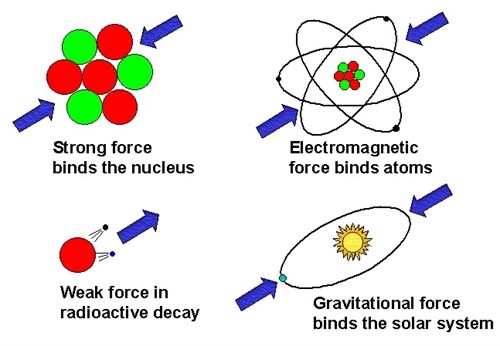Our universe is governed by 4 fundamental forces. At least that’s what physicists have long thought. However, new research suggests that there is a fifth force, a discovery that could surpass many modern physical theories.
Basic forces
In the history of science, we have only discovered four basic components of the natural force that makes up the universe. The world around us is in constant motion and development, but no matter how complicated, there are only 4 basic forces that make up the universe.
- Gravity: Gravity reigns in the macroscopic world and was discovered by Newton while sitting under an apple tree in the 17th century, which is important in the entire universe. It attracts these objects towards other objects. It keeps us on the ground, keeps the Moon orbiting the Earth; The planets orbit the Sun, keeping the stars in the galaxy and the galaxies in the galaxy clusters. What if without gravity, everything would float aimlessly in the universe. Therefore, this is the most common force in the universe, everything is affected by gravity, but it is also the weakest of the four natural forces.
- Electromagnetic force: Electromagnetic force was discovered in 1864 by Scottish physicist James Maxwell. The strength of the electromagnetic force makes it easy for a bar magnet to attract a nail despite the gravity of the magnet. the entire mass of the Earth acts on it, so the electromagnetic force is stronger than the gravitational force. The electromagnetic force makes atoms by forcing electrons (which carry a negative charge) to the nuclei. So without this force, the most elementary particles would not be able to bind and there would be no matter as it is today. This force also does not appear in all matter in the universe like gravity, it only interacts when particles have an electrical charge (either negative or positive), and non-charged particles like photons (light particles) or neutrons. there is no electromagnetic force.
- Weak force: One night in 1896, French physicist Henri Becquerel accidentally discovered atomic decay and discovered this weak force. Matter in general is not immortal, if we go all the way down to the sub-atomic scale we will find that very few of the hundreds of elementary particles are stable. The rest are mostly unstable particles, which are easily broken down into smaller stable particles. This force that drives decay and transformation is the force nicknamed “weak”. Although still much stronger than gravity, it is up to 1,000 times weaker than the electromagnetic force. Its domain of action is also very small. It has power only in the atomic world.
- Strong force: Atomic nuclei are collections of protons and neutrons. All protons carry the same positive charge, so the electromagnetic force causes them to repel each other (same sign repels, opposite signs attract). So why can they still exist in the nucleus of an atom? That is due to the strong force, the strongest of the four natural forces (It is 100 times stronger than the electromagnetic force). However, its range is also very narrow, only in the area where the weak force acts.
Fifth force
On October 23, researchers at the Institute for Nuclear Research in Hungary published a new study of the arXiv database that provides further evidence of an entirely new particle first proposed in 3 years before.
Dubbed X17, the particle could help scientists solve one of the biggest mysteries in astronomy: what dark matter is. The existence of particles would also require a rewrite of the standard model of particle physics, the theory that describes the fundamental forces and the classification of subatomic particles.
But that is only when the existence of the particle can be verified. “And most physicists are skeptical – in part because no outside scientist has been able to independently confirm the findings from earlier with the team,” said Richard Milner, a physicist at the Institute of Technology. Massachusetts technologist, who was not involved in the study, told Live Science.
The device used by physicists at the Institute for Nuclear Research in Debrecen, Hungary.
In 2016, a team of researchers reported the first evidence of the X17 particle, in experiments performed with radioactive beryllium atoms. Physicists measured the light and particles released by beryllium as it broke apart. They found that pairs of electrons and their antimatter counterparts, positrons, tend to slow down to a certain angle, behavior that seems inexplicable to existing physics.
The new study adds to many observations of the proposed particle, found in the decay of helium atoms. A similar experimental setup again shows evidence of an intermediate particle of the same mass.
The findings suggest that the proposed X17 particle is not a fermion – the type of particle that makes up ordinary matter – but a boson, a particle that carries energy and sometimes force.

